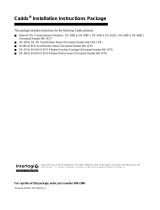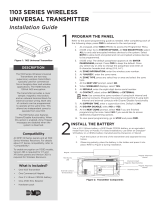Page is loading ...

466-2297A • November 2007
Copyright © 2007, GE Security Inc.
DesignLine Slim Door/Window Sensor
Installation Instructions
Introduction
This is the GE DesignLine Slim Door/Window Sensor Installa-
tion Instructions for models TX-1010-01-1 (white) and TX-
1010-01-3 (brown). You can install the sensor on doors,
windows, and many other objects that open and close. The sensor
transmits signals to the control panel when a magnet mounted
near the sensor is moved away from or closer to the sensor.
The sensor is equipped with a cover tamper for added security.
Installation guidelines
Use the following installation guidelines:
• Mount the sensor on the door frame and the magnet on the
door. If the sensor is used on double doors, mount the sensor
on the least-used door and the magnet on the most-used door.
• If possible, locate sensors within 100 ft. (30 m) of the panel.
While a transmitter may have a range of 500 ft. (150 m) or
more out in the open, the environment at the installation site
can have a significant effect on transmitter range. Some-
times a change in sensor orientation can help overcome
adverse wireless conditions.
• Make sure the alignment arrow on the magnet points to the
alignment mark on the sensor (Figure 2).
• Place sensors at least 4.7 in. (12 cm) above the floor to
avoid damaging them.
• Avoid mounting sensors in areas where they will be exposed
to moisture or where the sensor operating temperature range
of 0 to 120°F (0 to 49°C) will be exceeded.
• Use spacers (not included) to keep sensors and magnets
away from metal or metallic surfaces such as foil wallpaper.
• Avoid mounting sensors in areas with a large quantity of
metal or electrical wiring, such as a furnace or utility room.
Programming
The following steps describe general guidelines for programming
(learning) the sensor into panel memory. Refer to the specific
panel’s installation instructions for complete programming details.
1. To remove the sensor cover, press a small flathead screw-
driver into the slot on both sides of the sensor and turn the
screwdriver 90 degrees. This will disengage the clips
holding the cover and base. (Figure 1).
Figure 1. Sensor
2. Set the panel to program mode.
3. Refer to the panel/module documentation for learning
sensors.
4. Press and release the tamper switch on the sensor until the
panel responds (Figure 1).
5. Replace the base of the sensor.
6. Exit program mode.
Verify programming and RF communication
Before mounting the sensor, verify that the sensor mounting
location provides good RF communication to the panel.
To verify, do the following:
1. Put the panel/receiver into sensor test mode.
2. Take the sensor to the mounting location.
3. Hold the magnet next to the alignment mark on the side of
the sensor and then pull the magnet away from the sensor.
4. Listen for siren or keypad beeps to determine appropriate
response (refer to the specific panel/receiver installation
instructions).
5. Exit sensor test mode.
Mounting
To mount the sensor, do the following:
1. Remove the backing of a large piece of double-sided tape to
expose an adhesive surface. Place the exposed adhesive
surface on the base of the sensor.
2. Remove the backing from the remaining side of the double-
sided tape. Mount the sensor according to the installation
guidelines.
3. Use the remaining double-sided tape for the sensor magnet.
When mounting the magnet, line up the arrow on the
magnet with the middle line on one side of the sensor
(Figure 2). Mount the magnet no more than 0.4 in. (1 cm)
away from the sensor.
Figure 2. Mounting the magnet
+
+
SlotSlot
Tamper
switch
Battery
Battery
Cover on Cover off
Magnet Sensor
Alignment
mark
Maximum gap of
0.4 in. (1 cm)

DesignLine Slim Door/Window Sensor
Installation Instructions
2
Battery replacement
When the system indicates the sensor battery is low, replace it
immediately. Use the recommended replacement batteries (see
Specifications
) or contact technical support for more information.
To replace the batteries, do the following:
1. To remove the sensor cover, press a small flathead screw-
driver into the slot on both sides of the sensor and turn the
screwdriver 90 degrees. This will disengage the clips
holding the cover and base (Figure 1 on page 1).
2. Place a small flathead screwdriver in the slot between the
metal clip and the battery and twist the screwdriver slightly
while holding back one of the black plastic edges holding the
battery. Dispose of the old battery as required by local laws.
3. Insert the replacement battery with the + sign facing out.
4. Verify programming and RF communication with the panel.
See Verify programming and RF communication on page 1.
External contact
The sensor ships with a six-inch external contact lead. To use the
external contact, open the transmitter, plug in the external contact
header (J1), and connect the brown and blue leads to the external
contact.
Note: The external wire cannot be longer than 3.3 ft. (1 m).
FCC compliance
This device complies with part 15 of the FCC rules. Operation is subject to the
following conditions:
1. This device may not cause harmful interference.
2. This device must accept any interference received, including interference
that may cause undesired operation.
Changes or modifications not expressly approved by the party responsible for
compliance could void the user’s authority to operate the equipment.
FCC ID: B4Z-TX-1010-01
Industry Canada ID: 1175C-TX101001
Specifications
Battery Panasonic 2032, 3 VDC, 225 mAh, lithium
coin battery (5-year typical battery life)
Transmitter frequency 319.508 MHz (crystal controlled)
Transmitter frequency tolerance ± 8 kHz
Transmitter bandwidth 24 kHz
Modulation type Amplitude shift key (ASK)
Unique ID codes 16 million
Peak field strength Typical 30,000 uV/m at 3m
External input sampling current 20 uA
Reed switch magnetic sensitivity 10 to 20 amp turns
Reed sensitivity 0.38-in. (0.97-cm) gap
Magnet type Nd-Fe-B, N45
Magnet dimensions (WxHxD) 1.3 x 0.435 x 0.312 in. (3.3 x 1.1x 0.79 cm)
Supervisory interval 64 minutes
Operating temperature 10 to 120°F (-12 to 49°C)
Enclosure PC-540
Weight 0.55 oz. (15 g)
Dimensions (WxHxD) 1.00 x 2.45 x 0.35 in. (2.54 x 6.22 x 0.89 cm)
Colors White or brown
Technical support
Toll-free: 888.GESECURity (888.437.3287 in the US, including Alaska and Hawaii; Puerto Rico; Canada).
Outside the toll-free area: Contact your local dealer.
www.gesecurity.com
/


